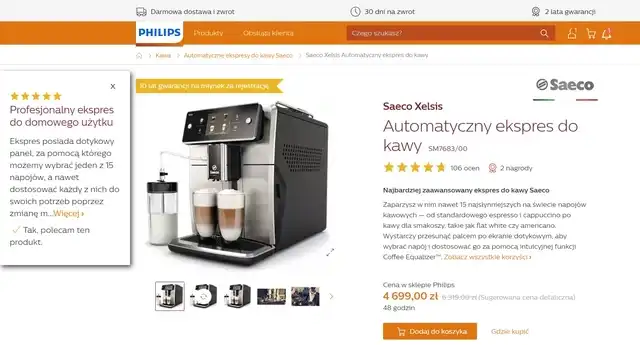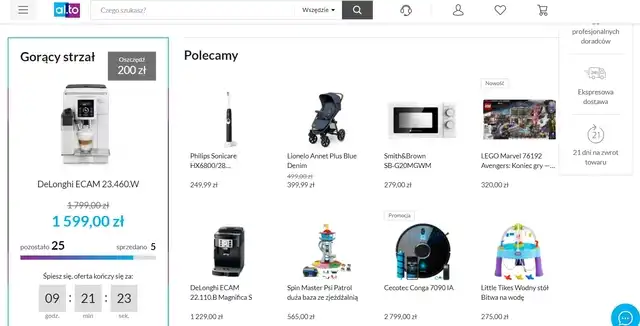What hides behind the terms "path to purchase ecommerce" or "purchase path"? What is the Path to Purchase in E-Commerce? Simply put, it's a process, a path that the online store customer must traverse from the moment they realize their need to fulfilling it with a product in question.
The convenience they will experience during individual stages of this process, as well as its understandability, intuitiveness, and straightforwardness, will influence their purchasing decision. The Path to Purchase's flawlessness, effectiveness, and customer-friendliness are also essential for an online store.
These values will support activities related to choosing and adding products to the cart and finalizing the transaction.
What else should you consider when designing and optimizing the Path to Purchase in E-Commerce? This article will answer this question.
The E-Commerce Path to Purchase: How do users buy in online stores?
From the customer's perspective, the buying process (consumer's path to purchase, customer journey) should provide supporting experiences that strengthen the purchasing decision.
And you should remember that the experiences the store's customers have are the source of the biggest and the most significant competitive advantage.
Designing and optimizing the Path to Purchase in the online store allows you to:
- Increase the sales volume
- Improve financial results
- Optimize marketing efforts
- Shorten customer journeys
Strengthen and deepen the loyalty of customers (retention).
Thanks to the analysis of the Path to Purchase, you can determine, e.g., which social media channels attract the most customers and, through that, obtain optimized marketing strategies and improved customer targeting.
Problems with the Path to Purchase are easy to diagnose. All you need to do is analyze two indicators: the Bounce Rate and the Conversion Rate.

Stores with high bounce rates and low conversion rates need to audit their Path to Purchase.
Much has been written in the subject literature about customers, their needs, and their types. We can recommend here our articles: "Who buys online? Types of E-Commerce customers" and "What do E-Commerce customers dislike in online stores?"
The available research can teach you about typical customer behavior, actions, goals, frustrations, and concerns.
The purchasing decision isn't a spontaneous reaction to an offer (it rarely occurs and applies to, for example, so-called impulse goods).
Instead, it's a process that requires time, engagement, and considerable work consisting of collecting and analyzing information, impressions, and emotions.
Of course, it's not always a conscious process, but when buying products in online stores, you are much less rational than you think.
Although you aren't always aware of that, you put significant importance on your experiences and emotive reactions.
This knowledge is essential in the Path to Purchase design process because it makes you realize how complex and multidimensional it is.
For instance, the time and the success of the purchase depend, among other things, on the following:
- Price of the product and budget available
- Type and specifics of the product
- Strength and type of the customer's need
- Credibility and trust inspired by the store
- Terms and conditions of the purchase and delivery
- Additional costs
- Age, gender, and social group.
The above list, obviously, doesn't exhaust all the reasons, conditions, and determinants.
However, you should remember that the method of purchasing in the online store is repetitive, individually and collectively, and has a relatively stable structure.
Awareness of the customer's shopping condition at every stage of the Path to Purchase allows you to understand their goals, the means they will want to use to achieve them, and the expectations they will form toward the online store.
An in-depth analysis of these matters should lead to the implementation of appropriate design solutions that will support the customer in overcoming subsequent stages of the Path to Purchase in a way that is the most compatible with their expectations.
How to design the Path to Purchase of the online store customer?
For a potential customer to want to make a purchase, they must first have a need that the product can meet. Moreover, they need to know, at least in general, what kind of product and which manufacturers can fulfill this need.
This moment is defined as an awakening of Awareness in the subject literature.
The need usually expresses itself in the form of sentences beginning with an expression of its strength, reason, and justification of the purchase.
For example, the sentence "I would like to have a better graphic card so I could play the latest game" expresses the desire to own and the condition of meeting the need.
However, if you start the same sentence with "I have to have..." you also receive information about the strength of the need and the emotions it evokes.
Determining the power of this need — possibility or necessity — is a matter of research and a more thorough understanding of customers' functional and emotional needs.
From the perspective of E-Commerce User Experience and the customer experience in the online store, the formulation of needs determines the reasons, goals, and emotions that should be accounted for in the design of the Path to Purchase.
With that said, it's not only about arguments and convincing users to buy through benefits but also about using solutions regarding the store's operation (such as navigation or functionalities).
Awareness breeds interest and Consideration, expressed in the active expansion of knowledge, which should result in an initial willingness to purchase.
An inseparable part of shopping is the selection that enables customers to familiarize themselves with the market offer and evaluate which product from the collection of similar products will be the best from the standpoint of E-Commerce customer needs.
Selection is a process directly proportional to the complexity of the product (in terms of use and operation) and the level of risk involved in its purchase.
The cheaper the product and the more frequently bought, the fewer reference points, measurements, comparisons, dilemmas, and opinions a potential customer has to use before making the purchase decision.
For example, a high-tech gaming laptop requires a much longer and more complicated evaluation method than buying a computer mouse.
The "Convinced" customer has nothing left to do but buy the product (Acquisition) and share their opinion in spontaneous conversations or a review on a product page.
The role of User Experience in the online store purchasing process
A common mistake made during the design of the Path to Purchase is a conviction that customer experience is only significant when the product is added to the E-Commerce shopping cart. Nothing could be further from the truth.

Experiences appear at every moment of customer interaction with the online store. The store's design aesthetic, functionality, and usability breed specific attitudes, emotions, evaluations, and behaviors.
While analyzing the customer's experience in the online store, you should pay special attention to the purchasing process and the Path to Purchase from their perspective.
Notably, you should keep in mind whether the customer:
- Achieved their goal
- Traversed the Path to Purchase in a simple, fast, and trouble-free manner
- Experienced negative emotions during the purchase process.
That's why you should account for customer experiences at every stage of the buying process.
Looking for opinions is very common, and rating systems on product cards usually provide them.
A good way of presenting crucial information considerably improves customers' impressions of the online store.
Offering tools, information, opinions (from experts and buyers of the product in question), ratings, recommendations, benchmarks, and tests should be oriented toward customer needs.
The latest graphic card is not the best choice because it has the best parameters but because it allows customers to play the most demanding games regarding system requirements.
More importantly, it lets them play trouble-free and provides the best experiences regarding the smoothness of the gameplay, quality of the graphics, or special effects — in summary, it increases customer satisfaction.
What should you pay attention to when designing the E-Commerce Path to Purchase?
Since the Path to Purchase is about actions and, in the strict sense of the word, it is a process; you should analyze it in terms of online store customers' behavior.
Its design has to be preceded by thorough research and analysis, which should answer the following questions:
- What is the typical customer of the store like?
- What kinds of actions do customers perform?
- Why do they do them?
- What actions are not performed even though they were included in the scenarios?
- Why are specific actions not performed?
- How can customer engagement be increased?
Every action involves feelings, emotions, attitudes, and evaluations. Hence, insight into E-Commerce customers' reactions and overall customer data is crucial.
In particular, it is essential to discover the problems accompanying them during the Path to Purchase journey.
For example, to what degree was the buying process understandable to them? To what extent it appeared to them as thoughtful and logical, with a clearly defined purpose?
While optimizing the Path to Purchase in the online store, you should remember a few general problems.
You should pay attention to the following:
- Technological issues
- Informational issues
- User Experience issues
How the store operates is evaluated first in terms of how fast each subpage loads.
The instantaneous display and presentation of the entire content of a particular subpage is a common expectation, and that's why you should pay special attention to this matter.
A slow store (the page loading time should not exceed 3 seconds) that doesn't guarantee flawless and smooth interaction is considered useless and unreliable. It evokes negative emotions and doesn't encourage purchase.
The first impression effect regarding speed means that unfavorable predictions automatically appear.
The customer may think that since the home page loads for an eternity, the purchase will also last forever. In that case, it's not worth it to bother shopping in such a place. The customer will feel that they're right and won't be alone in this feeling.
Information — product descriptions and specifications — also play a significant role in the decision-making process. In particular, a reliable, complete, and understandable presentation of the product's attributes, variants, configurations, and requirements (such as the need to buy additional products).
Opinions and ratings are also desired and valuable from the perspective of the store's customers. We've written more on designing rating systems in the article "Rating Systems in online stores."
Now, we will only remind you that they're essential for awakening awareness and discovering the needs and considerations. Furthermore, the majority of E-Commerce customers expect such functionalities.
They are an important indicator of the store's credibility. That said, remember that one-sided positive opinions or one-sided negative opinions are received as unreliable.
Rating systems, recommendation systems, and opinions of other customers (based on social proof) are not only valuable sources of knowledge but also strengthen or discover needs that have not yet been realized.
Customers are not always thoroughly familiar with the products' functions, qualities, attributes, features, and uses.
The availability of this information has a significant role. It expands the awareness of the customer, and it is a valuable argument that convinces them to buy.
A hotline fulfills a similar function: the customer should be able to obtain exhaustive information about the product and the offer through the hotline.
Optimization of the Path to Purchase — how to do it?
Optimizing the Path to Purchase aims not only to inform the customer but also to convince them to buy.
The store must be more than a source of valuable information; it should also offer simple, straightforward, and convenient shopping.
Buying in E-Commerce today can be done in several configurations:
- Familiarization with the offer and buying online.
- Familiarization with the offer online and buying in the stationary store.
- Familiarization with the offer in the stationary store and buying online.
Offering various channels (mobile, desktop) is a standard today, and customers often view the store's offer on a desktop device and finalize the purchase on a mobile device.

Therefore, you should tailor the Path to Purchase to the needs and actions while simultaneously offering a consistent and continuous process.
While designing the Path to Purchase, you should accommodate customers' needs regarding omnichannel.
The integration isn't only about types of devices but also about combining online and offline channels into a consistent system that results in harmony.
Omnichannel shopping demands the implementation of deep and efficient integration of channels, which will make it possible to improve sales results. It also means focusing on customer experience.
In general, the customer should perform as few actions as possible during the purchase process, requiring minimal engagement and work from them. The cost of interaction with the store should also be as low as possible.
Accurate information and toleration of typical errors help achieve this goal.
Trust in the store is a product of security and understanding of mistakes.
To a large extent, loyalty is a matter of how the store works. It's a testament to its standard of service, not just the price or terms regarding order fulfillment. You should keep this in mind.
Typical mistakes made during the designing of the Path to Purchase
It's very discouraging to force store's customers to create accounts when buying.
Offering the option of purchasing without the need for registration is recommended, and it's an important argument that you should appropriately emphasize.
As mentioned, the purchase process should be as simple as possible and compatible with customers' expectations and habits.

For example, the amount of data entered into a form should be as minimal as possible, and its validation should not require the customer to repeat it when making a mistake.
The number of required fields and the tolerance for mistakes are perhaps the most common reasons for abandoning the shopping cart and searching for the product in another store.
The simplicity and intuitiveness of the online store interface also have significance.
The interface should be designed to shorten the Path to Purchase and make it as intuitive and understandable as possible.
The ease of its passage means that the customer can quickly reach the item, continue shopping, and make fast and trouble-free payments.
Often incorrectly designed links (such as "continue purchase"), buttons (Back button), and the lack of Breadcrumb navigation make the Path to Purchase (and the customer journey as a whole) seem illogical, confusing, and frustrating.
How to design the Path to Purchase in E-Commerce? Summary
- The Path to Purchase is a process, a path, and a part of the customer journey that the online store customer must traverse from the moment they realize their need to fulfilling it with a product in question.
- The buying process should be the source of experiences that strengthen the purchasing decision.
- Experiences appear at every moment of customer interaction with the online store.
- Auditing and optimizing the Path to Purchase increases the sales volume in the online store, improves retention, and helps you maximize marketing efforts.
- The purchasing decision is a process that requires time, engagement, and work.
- Awareness of the customer's shopping condition at every stage of the Path to Purchase allows you to understand their goals, the means they will want to use to achieve them, and the expectations they will form toward the online store.
- Therefore, you should tailor the Path to Purchase in terms of omnichannel in order to achieve, among other things, enhanced customer experience.
- It's essential during optimization and designing to provide maximal consistency of the Path to Purchase.






